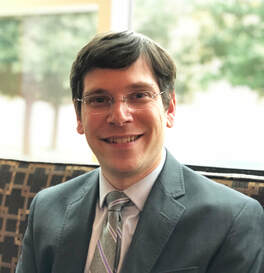 by Rabbi Adam Roffman One of the things that I love about being Jewish is that we are commanded to feel. God tells us that we must love Him. The Torah teaches us that we must be joyful on Festivals like Sukkot. And our sages insist that, even at a wedding, we should hold some sadness in our hearts for the sufferings of our people. For me, Judaism is often like a very powerful mood drug. Even if I’m commanded to feel sorrow, I’m grateful, because I know the emotion it evokes is an appropriate and even a productive one. We are now most of the way through the month of Adar I (this a leap year, so there are two months of Adar), a time associated with the ancient saying, “mi shenichnas adar marbim b’simcha” – those who embrace the month of Adar merit an overabundance of joy. For thirteen days, we anticipate the raucous celebration of Purim, and in the two weeks following we bask in the afterglow of one of the sweetest and most festive days of the Jewish year. But as you can imagine, maintaining this joyful countenance for a month straight—and this year for two months—is quite a challenge. The natural high of entering into this season only lasts so long. So, I often find myself looking ahead, planning moments of joy to ensure that I wear a smile on my face for as much of Adar as possible. This past Shabbat, we certainly succeeded in creating a moment of great happiness for our community. As we welcomed Dr. Benjamin Sommer, our Scholar-In-Residence, we also marked the first of what I hope will be many annual Shabbatot dedicated to the memory of Irene Kogutt, z’ll, a beloved figure in our community. Irene was a devoted member of our Shabbat morning Torah Study class, the Topletz Minyan, and our Adult Education classes for many years. She also made an extra effort to study on her own, with her chevruta Susan Ehrlich, in anticipation of her adult Bat-Mitzvah, no doubt one of the most joyful days of her life. That Irene so steadfastly pursued the mitzvah of Torah study was reason enough to honor her, thanks the generosity of her family and the many of our members who contributed to the Kogutt fund for Scholars-In-Residence in her memory. But what was also so fitting about this past Shabbat was that it fell right in the middle of the month of Adar. If the practice of Judaism is a mood drug, a surefire way to lift your spirits, so was the occasion of spending time with Irene. Except for the times when she expressed serious concern about my parenting skills (which, fortunately, was not too often), Irene always, always, had a smile on her face. She made the study of Torah joyful through her presence, her curiosity, and her infectious spirit. Even today, more than a year after her passing, it is impossible not to think of her and smile – even grin. This month, I pray that we continue to find ways of marking our time with joy – by honoring and remembering those we love, by committing ourselves to the study of our tradition, and by giving ourselves over to the celebration and the revelry of the season of Purim. Happy Adar!
0 Comments
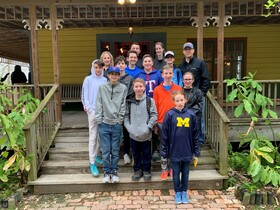 by Sarah Lipinsky Nonstop laughter as we rode the bus, the constant reminders to lower the intense volume from chatty voices, and the endless question-asking of twelve eighth graders, made for four amazing, 16-hour days—and I would do it all again in an instant. This past weekend the 8th graders from DeReKH visited New Orleans for a social action trip. Our main focuses were on gemilut hasadim (acts of kindness) and successfully integrating our Shearith teens with their new friends from DeReKH. On day one, we volunteered at Lower 9th Resilient. That afternoon everything the DeReKH leadership team had hoped for fell in place. Naturally. All the teens bonded, talked, and helped one another as we gardened together in the Lower 9th Ward.
Spending Shabbat together in New Orleans was incredibly memorable. The teens led Shabbat services, and two of the teens, one from Anshai and one from Shearith, led Shabbat shacharit in unison. We studied tzedakah versus gemilut hasadim and learned why acts of kindness are greater than giving tzedakah money. We learned about diversity, economic disadvantages, and poverty in New Orleans where the division of rich and poor is uncomfortably clear. Then we discussed the realities of Dallas’ financial divide. Most of us spend our time between the tollway and Coit Rd, but on the outskirts of this bubble almost 25% of Dallas residents live below the poverty line. Studying and working together blended and strengthened our DeReKH students. Getting to witness this was the highlight of the trip. I learned how bringing together Shearith, Anshai, and Beth Torah for a joint high school program made DeReKH a truly great program. We not only provide the teens of these three communities with the best religious school education in town, but we create an ideal, holistic experience for all conservative teens across DFW. 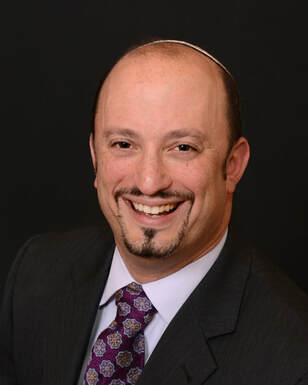 Sermon--Parashat Terumah 5779 Tiny Treasures Shabbat, 2/9/19 by Rabbi Ari Sunshine According to a teaching of Rabbi Elazar Ha-Kappar in Pirke Avot (4:22), the Ethics of our Fathers, a collection of rabbinic wisdom and maxims included in the Mishnah some 1800 years ago, when we are born, we are actually born into the world against our will. Which is to say that no one consulted with us or asked our opinion before our arrival on this earth. And, moreover, we were also born into a world that had already benefited and suffered many times over because of choices our predecessors had made for us. We had no say in the matter of where our parents lived, how they made their living, whether they were compatible, or whether they provided us with food, clothing and shelter, even though every one of these factors had an impact on our lives when we began to live them. This idea that our world and some of our options and circumstances have already been shaped and constrained by decisions others have made seems to run counter to our society’s insistence that a persistent individual can determine his or her own destiny. While it’s true that there is certainly much that we can accomplish owing to our own individual initiative, we are also enmeshed in a larger context that is not of our own creation or doing that impacts our lives. In that way, we are often dependent on the foresight of those who came before us, in much the same way that our children will ultimately face the consequences or reap the benefits of the choices we make—or don’t make—today. This week’s parasha, Terumah, speaks to this interconnection of the generations quite clearly through an interesting and surprising detail we encounter in the parasha. In the early stages of the Israelites’ wandering through the Sinai wilderness, God instructs them to gather material with which to build the Mishkan, the portable Tabernacle that will serve as the symbolic home for God’s presence in their midst. Among the specific materials listed in Shemot, Exodus 25:4-5, we find “gold and silver and brass, and blue and purple and scarlet yarn, and fine linen and goats’ hair, and skins of rams dyed red, and skins of seals, and acacia wood.” While I realize too much goats’ hair might have required the invention of the world’s first lint brush, it’s not the inclusion of the goats’ hair that particularly puzzled the rabbinic sages. Rather, it is the mention of the atzei shittim, the acacia wood. Rashi, in his 11th century commentary, asks the obvious question, “From where did they obtain this in the wilderness?" After all, there are no acacia trees in the desert! How could God expect the Israelites to be able to obtain this type of lumber? Gersonides, the 14th century French philosopher and commentator also known by the acronym Ralbag, suggests that the Israelites might have cut down this wood in one of the places they passed through on the way in order to make furniture, and now donated whatever of it they had for the purpose of constructing the Mishkan. Don Isaac Abarbanel, the 15th century Portuguese commentator, explained the disconnect by noting that most probably this wood, like the oil and spices, was purchased from the neighboring peoples who came to the Israelite camp to sell things. But Rashi in his day offered up a different explanation, which he brought from the Midrash Tanhuma, which was that our patriarch Jacob prophesized through God’s Divine Spirit that his descendants the Israelites would one day build the Tabernacle in the wilderness. So Jacob brought cedars—he believed the acacia was a kind of cedar—down to Egypt with him, planted them, and instructed his children to take them along when they left. According to Rashi’s answer, our ancestor Jacob showed foresight and anticipated the needs of a future generation and then went out of his way to plan for and provide for those needs. He did not personally have any need for cedars or acacia wood, nor did he personally reap any benefit from them. Moreover, schlepping wood and trees along may have seemed like an unnecessary encumbrance to his family and contemporaries. Yet Jacob knew that his descendants would need it—and for a sacred purpose, no less—so he went the extra mile to provide it for them. This kind of selflessness and foresight is not always common, so it’s not surprising to see that the Midrash attributes Jacob’s foresight to ruach ha-kodesh, Divinely inspired prophecy. In a similar vein, some of us may be familiar with the oft-cited Talmudic legend of Honi ha-m’agel, Honi the circle maker, and the story of his encounter with a man planting a carob tree. Honi asks the man how long it takes for the tree to bear fruit, to which the man replies, “70 years." Honi, puzzled by this response and thus the seemingly illogical action this man is taking, asks further, “So, are you sure you’ll be living for another 70 years?” And to this inquiry, the man responds, “I found a world full of carob trees. Just as my ancestors planted for me, so I plant for my children.” Honi then sits down to a meal, finishes eating, gets tired, and falls asleep for 70 years—according to the legend, no one found him in all that time because a rock formation grew around him and hid him from view. When he finally wakes up, sure enough, he sees a carob tree near him and a man picking fruit from the tree, prompting Honi to ask the man if he was the one who planted the tree. The man informed Honi that he was, in fact, the man’s grandson, to which Honi replies that now he knows he must have slept for 70 years. (Babylonian Talmud, Tractate Ta’anit 23a) In our own day and age, there are multiple parallels to Rashi’s midrashic explanation for how the Israelites obtained the acacia wood cited in our parasha and the Talmudic story of Honi and the man who planted the carob tree. First of all, the unnamed man in the story planted a carob tree so that his grandchildren and great-grandchildren would have fruit in their lifetime, and Jacob planted trees that his children would need some 400 years later. Thus, like Jacob in the midrash and the concerned carob-tree planter in the story, it is important that we remember to measure our choices and actions by their consequences that extend forward multiple generations hence, not just by our short-term wants and needs. This approach most certainly applies to taking care of our society, our environment, and our planet. But this parallel is also apt for Judaism and our Jewish communities. Specifically, when we “build” our own Judaism and our synagogue communities, we need to be forward thinking and not reactive, avoiding the trap that I know I’ve paraphrased here before in the name of Rabbi Ed Feinstein—one of the rabbis here at Shearith back in the day--that American Jews are really good at building synagogues that their parents and grandparents would have loved. We have an unfortunate habit in the modern Jewish world of either looking backwards at “glory days” gone by or being content to tread water in the present. We should be satisfied with neither if we are really intent on creating a vibrant Jewish future. Yet it is important to note in this vein something that we also often lose sight of: our children and grandchildren can only inherit what we ourselves possess. If we don’t plant and cultivate nourishing trees of life, as it were, meaningful Jewish experiences for ourselves that engage and inspire us regularly through the weeks of our year, then what exactly are we passing on to our children and grandchildren? We want to bestow on them values and guidance that will help them in their Jewish journeys when they are ready, and Jewish memories they would want to hold on to and cherish like a treasured possession. So this is the challenge we face, the delicate balance we must strive for: creating a living and evolving Judaism and synagogues and Jewish communities that both resonate with us AND will resonate with our children and grandchildren. And this week, and today in particular, we are witness to the nexus of this balance, with the presentation of Shearith’s Strategic Plan, “Ma’alot: Ascending New Heights” and our celebration in a few minutes of our Tiny Treasures, many of the new babies who have been born in our Shearith community during these last 12 months. The general focus of Ma’alot is to push us to build on the solid foundation we have already established at Shearith and move forward and upwards from here in all the broad areas of our congregational life and culture, inviting more participation and engagement and inspiring others to join in and rally around our mission, vision and values. This upward push towards creating an even more sacred community than the one we are already part of means involvement of all demographics in our congregation, from our eldest seniors, even 101 year old Alex Jonas who recently told his son Hylton how excited he was to see how much was going on at the shul, all the way down to our littlest babies and their families who we’ll be welcoming into the sanctuary momentarily. And, regardless of what demographic each of us fits into, it is these beautiful little babies and their sweet faces—well, when they’re not crying, anyway :) —that remind us what is at stake in the long run with the work we’re doing. We want these Tiny Treasures—our tiny treasures—to treasure the Judaism and the community that we are building and re-shaping for us and for them—and then, one day, to have that same foresight as our ancestor Jacob and the carob tree planter did and bequeath a compelling legacy, mission, and framework for living to their children and grandchildren. This is the holy responsibility we are holding in our hands at this crossroads. May we be worthy stewards of our tradition and our congregation for ourselves and for the generations who will follow us. AMEN. 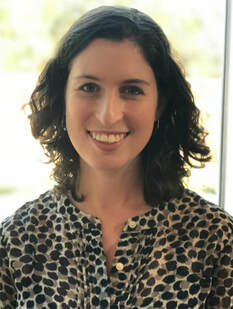 by Rabbi Shira Wallach This past Shabbat, we welcomed our new class of Tiny Treasures—babies born in the year 2018—and their families into the warm and loving embrace of the Shearith Israel family. If you were there, thank you for helping us create such a wonderful space in which to share in the simcha of new life. 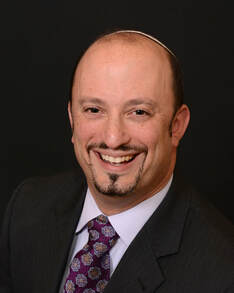 D’var Torah for Strategic Plan Rollout Meeting 2/6/19 Congregation Shearith Israel by Rabbi Ari Sunshine Is anyone here familiar with the Talmudic debate between Hillel and Shammai about how to light Hanukkah candles? The school of Shammai believed that we should start off with eight candles on the first night and then take away one candle per night until we’re left with only one candle plus the shamash, the helper candle, on the last night, whereas the school of Hillel opined that we should start with one candle on the first night and gradually increase by adding a candle a night until we have eight candles plus the shamash on the eighth and final night. Well, I think we know how that one worked out—as was the case with all but a handful of the several hundred Talmudic debates between Hillel and Shammai, with Hillel coming out on top. But how many of us know the reasoning behind Hillel’s position for the Hanukkah candlelighting? His explanation is “ma’alin ba-kodesh, v’ein moridin”—when it comes to matters of holiness, we only increase or ascend, we don’t decrease. In the hanukkiah-lighting context it certainly intuitively makes sense that it would be more impressive and climactic to build to the finale of the full hanukkiah with eight candles plus the shamash burning brightly to illustrate the miracle of the oil that our sages said should have lasted for only one day but instead lasted for eight. But in his explanation Hillel doesn’t focus on that logical rationale that would be specific to the hanukkiah; instead, he focuses on this general principle, that when we’re dealing with sacred matters we want to keep reaching higher. We do see other examples of this principle in play in our tradition, like in the symbolic choreography of the kedusha in the Amidah when we go up on our tiptoes three times as we pronounce the words from the prophet Isaiah, “Kadosh, Kadosh, Kadosh, Adonai Tzeva’ot; M’lo kol ha-aretz K’vodo”---“Holy, holy, holy, is the Lord of hosts, the earth is full of God’s glory,” like in the scripting of 15 Psalms, Psalms 120-134, with the introductory words, “Shir Ha’Ma’alot," “A song of ascents,” linked by the early rabbis to the ascent up the 15 steps where the Levites sang on their way up to the Ancient Temple in Jerusalem. Perhaps most well-known to all of us here today is the use of the term “Aliyah,” “going up.” to refer to someone who chooses to move from the Diaspora to Israel to make their life there, thus making a spiritual ascent to a different kind of life in our Jewish homeland. It is in this same spirit of sanctity and holiness that we decided to title our new Strategic Plan “Ma’alot," “Ascending New Heights.” During this last year and a half our Strategic Plan Chairs, along with our Committee, Foundation chairs members, Klei Kodesh and staff have invested hundreds of hours of thought and effort in helping us hone in on and sharpen our focus and priorities for this next chapter of our congregation’s history. In doing so we have emerged with a Strategic Plan that we think you will find to be worthy of its aspirational title. We hope this plan will challenge us to build on our successes and what we’re already doing well, strive to live up to our new mission, vision and values statements, and also serve our congregants’ needs even better. We’ve already been making steady progress in revitalizing our congregation in recent years, but there are new and different heights for us to climb still as we rise to meet the challenges and opportunities presented by the changing landscape of 21st century American Judaism. We invite you to be our partners in this vital, and holy, effort as we push ourselves to be the type of Kehilla Kedosha, sacred community, we yearn for and are excited and energized to be a part of. Please click HERE if you are excited about our future and wish to help. Todah Rabbah (Thank you!). |
Details
AuthorsShearith Israel clergy, staff and congregants share Archives
April 2023
Categories
All
|

 RSS Feed
RSS Feed